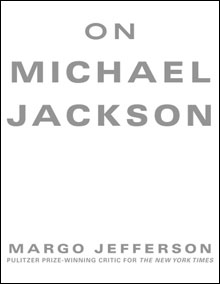 Is there a more perfect subject for cultural criticism than Michael Jackson? What angle do you want to play him from? The many facets of his pop-stardom? Singer, dancer, songwriter, MTV pathbreaker, superstar, “a one-man conglomerate with global reach.” There are the overarching themes of race, gender, sexuality, celebrity, and finally mental illness. There’s the abused child who becomes, it’s alleged, an abuser. There’s a wildly dysfunctional family, an up-from-poverty success story, Hollywood, and cosmetic surgery. There’s phenomenal talent. There’s a scandal. A trial.
Is there a more perfect subject for cultural criticism than Michael Jackson? What angle do you want to play him from? The many facets of his pop-stardom? Singer, dancer, songwriter, MTV pathbreaker, superstar, “a one-man conglomerate with global reach.” There are the overarching themes of race, gender, sexuality, celebrity, and finally mental illness. There’s the abused child who becomes, it’s alleged, an abuser. There’s a wildly dysfunctional family, an up-from-poverty success story, Hollywood, and cosmetic surgery. There’s phenomenal talent. There’s a scandal. A trial.
New York Times cultural critic Margo Jefferson covers it all in this compact book-length essay on Jackson and his career, contextualizing and decontextualizing (from the end notes, it’s clear that scores of books went into the making of this little book), reading all the codes and signifiers. In lesser hands — after decades of post-structuralist theory’s seeping into the mainstream — what Jefferson does here could have come off as bloodless, an academic parlor trick. Quicker than you can blink, she’s placed Jackson in the long lineage of the freak show, tracing him all the way back to P.T. Barnum (whom, she points out, Jackson has read about assiduously). Her close readings of Jackson’s videos and television performances are virtuoso. But the difference between Jefferson and the academic theorist is that Jefferson comes to Jackson with the point of view of a fan who happens to be a black woman.
She begins with a chapter called “Freaks” in which she makes the point that Jackson is both P.T. Barnum and the freak in his own sideshow, “both producer and product.” This is the Jackson who identifies with E.T., Peter Pan, and Edgar Allan Poe (“the only character besides Peter Pan that Michael Jackson planned to play in a movie”). Then, of course, there’s the Elephant Man. Jackson “claimed he saw the movie thirty-five times, never once without weeping all the way through! He made repeated attempts, offered millions of dollars, to buy the bones from The British Museum.”
This is the Michael Jackson who is both monster and innocent in videos like “Thriller,” always the double. Jefferson takes us through the “Billie Jean” video and Michael’s split-second signifying: hoofer cavalier, soul man, song-and-dance man, “fifties bad boy.” And she’s just as good reading the registers of diction in a Barnum poster (“the language of the sideshow with touches of natural-history-museum rhetoric”).
She takes us into the Jackson family life, with stern, brutal father Joseph and too saintly Jehovah’s Witness mother Katherine. She avoids easy pop-psych terms like “enabler” to describe Katherine, because there’s so much more to her than that: “Every bit of pain, every setback, becomes proof of Katherine’s goodness, her capacity for sacrifice.”
There’s more here, about the history of child stars, from Buster Keaton, Jackie Coogan, and Sammy Davis Jr. through to Michael. “Nothing charms grown-ups like seeing kids imitate them. . . . They embody adult secrets, and that gives us the upper hand.”